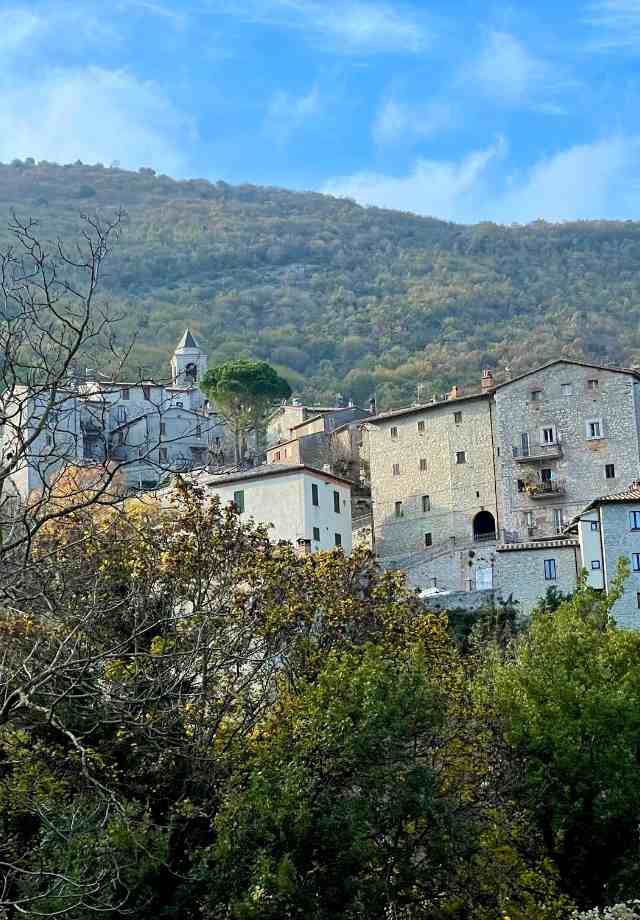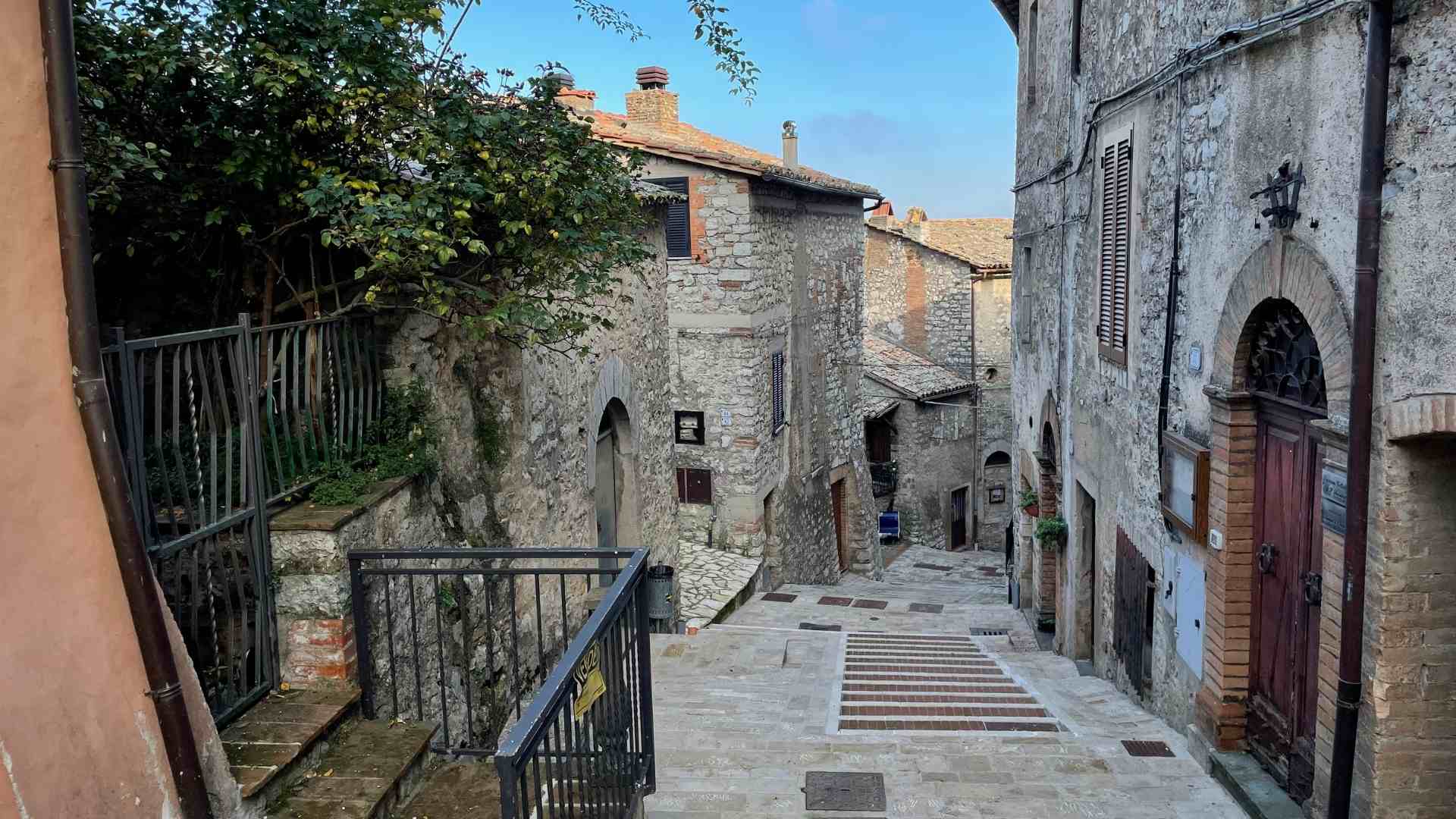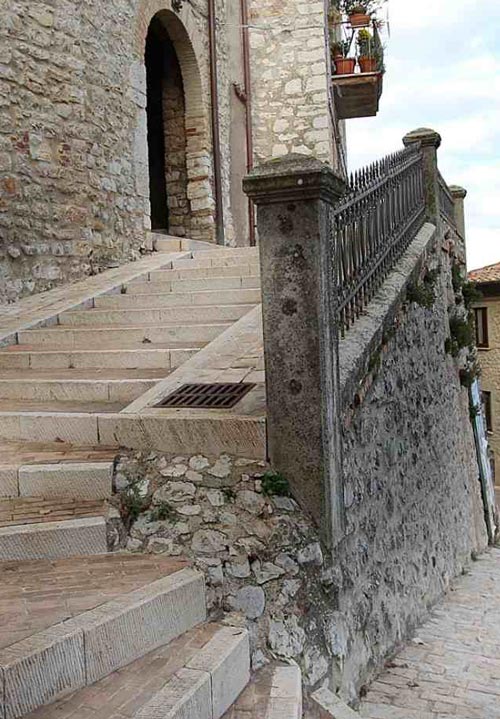
punto di interesse
point of interest


Surrounded by woods of centuries-old chestnut trees, flowering ash and maples, and characterized by the long staircase that divides the village in two, Santa Restituta stands on the slopes of Mount Rotondo in the territory of the municipality of Avigliano Umbro in the province of Terni.
Its splendid loog dates back to the medieval period but the origins of the people who lived in this territory are lost in prehistory as attested by the wonderful Grotta Bella hypogean environment on Mount Aiola, distant about 3 kilometers, which has a use from the Neolithic to the Roman period.
It seems that the first real settlement, called Castello di Restituto, was on top of Mount Pianello and already active in the Arnolfi era. Following its destruction, the castrum was rebuilt on the current site, of which we have certain news only from 1220 when it became part of the Tuderte territory.
The castle was not (and is not) characterized by a real city wall, but it is the same houses to form – one on top of the other – a sort of defense line with towers and walls in support.
At one time the entrances were four, two at the top, two at the bottom. Today there are two entrances: one at the bottom, the other at the top at the Church of Santa Restituta placed at the beginning and at the end of the characteristic staircase that divides the interior of the village in two.
At the end of the thirteenth century, when the territory of Todi was divided into 19 parishes, the Santa Restituta Castle, like that of Toscolano they were ascribed to those of the parish church of Santa Maria in Gallazzano located, according to the sources, right in the basement of the parish house of the village.
Destroyed by Corrado Anastagni from Foligno in 1306, it was involved in the fifteenth century in the struggles between the Chiaravalle and the Atti.
At the end of the same century it was involved in the descent of Charles VIII who occupied it with 3,000 soldiers and asked for the ransom in Todi.
In the following years the struggles that raged in these areas, did not spare even Santa Restituta who, like the others hamlets, lived a long period of famines and epidemics.
Typical medieval village within the territory of the Amerini Paths, Santa Restituta preserves jewels such as the Church of Santa Maria Novella with frescoes of the fifteenth century and the statue of the Madonna del Pero.
Just outside the walls, the Church of San Luigi of the eighteenth century dedicated to San Luigi Gonzaga in honor of which an altar was erected in 1739. In the church is venerated the Madonna del Meschino, an image of the Virgin and Child carved into the rock.
In the small and characteristic cemetery, immersed in the chestnut woods, is inserted the ancient Church of San Michele of the thirteenth century which preserved, until the fourteenth century, the relics of Santa Restituta di Sora and those of Santa Restituta di Teniza (Africa).
A short distance from the town, stood the Castle of Paragnano today a simple farmhouse.
Very interesting, on the mountain the Aiola is the Grotta Bella, an underground environment of considerable geological and archaeological importance.
Remarkable is also a monumental maple of over two hundred years called for this Acerone, naturalistic pride of the Amerini Paths located a short distance from the path 746 – Alta via dei monti amerini.

Surrounded by woods of centuries-old chestnut trees, flowering ash and maples, and characterized by the long staircase that divides the village in two, Santa Restituta stands on the slopes of Mount Rotondo in the territory of the municipality of Avigliano Umbro in the province of Terni.
Its splendid loog dates back to the medieval period but the origins of the people who lived in this territory are lost in prehistory as attested by the wonderful Grotta Bella hypogean environment on Mount Aiola, distant about 3 kilometers, which has a use from the Neolithic to the Roman period.
It seems that the first real settlement, called Castello di Restituto, was on top of Mount Pianello and already active in the Arnolfi era. Following its destruction, the castrum was rebuilt on the current site, of which we have certain news only from 1220 when it became part of the Tuderte territory.
The castle was not (and is not) characterized by a real city wall, but it is the same houses to form – one on top of the other – a sort of defense line with towers and walls in support.
At one time the entrances were four, two at the top, two at the bottom. Today there are two entrances: one at the bottom, the other at the top at the Church of Santa Restituta placed at the beginning and at the end of the characteristic staircase that divides the interior of the village in two.
At the end of the thirteenth century, when the territory of Todi was divided into 19 parishes, the Santa Restituta Castle, like that of Toscolano they were ascribed to those of the parish church of Santa Maria in Gallazzano located, according to the sources, right in the basement of the parish house of the village.
Destroyed by Corrado Anastagni from Foligno in 1306, it was involved in the fifteenth century in the struggles between the Chiaravalle and the Atti.
At the end of the same century it was involved in the descent of Charles VIII who occupied it with 3,000 soldiers and asked for the ransom in Todi.
In the following years the struggles that raged in these areas, did not spare even Santa Restituta who, like the others hamlets, lived a long period of famines and epidemics.
Typical medieval village within the territory of the Amerini Paths, Santa Restituta preserves jewels such as the Church of Santa Maria Novella with frescoes of the fifteenth century and the statue of the Madonna del Pero.
Just outside the walls, the Church of San Luigi of the eighteenth century dedicated to San Luigi Gonzaga in honor of which an altar was erected in 1739. In the church is venerated the Madonna del Meschino, an image of the Virgin and Child carved into the rock.
In the small and characteristic cemetery, immersed in the chestnut woods, is inserted the ancient Church of San Michele of the thirteenth century which preserved, until the fourteenth century, the relics of Santa Restituta di Sora and those of Santa Restituta di Teniza (Africa).
A short distance from the town, stood the Castle of Paragnano today a simple farmhouse.
Very interesting, on the mountain the Aiola is the Grotta Bella, an underground environment of considerable geological and archaeological importance.
Remarkable is also a monumental maple of over two hundred years called for this Acerone, naturalistic pride of the Amerini Paths located a short distance from the path 746 – Alta via dei monti amerini.

Naturalistic excellence in the territory of the Amerini Paths, it is the place of departure (or arrival) of some of the most beautiful paths of Amerino:
In the territory there is also the Path 746 – Alta via dei monti amerini.
Also interesting is the first stage, from Tenaglie to Melezzole, of the Way of the Silent Villages.

Naturalistic excellence in the territory of the Amerini Paths, it is the place of departure (or arrival) of some of the most beautiful paths of Amerino:
In the territory there is also the Path 746 – Alta via dei monti amerini.
Also interesting is the first stage, from Tenaglie to Melezzole, of the Way of the Silent Villages.

Discover the points of interest near the village:
Discover the Church of Santa Restituta
Discover Grotta Bella
Discover l’Acerone (Ancient Maple)
Reach Toscolano
Or:
discover all the points of interest of the village
Information, appointments and travel proposals on:
The Progressive Web App is part of the project “Le Terre dei Borghi Verdi”, realized in collaboration and with the contribution of Regione Umbria – Assessorato al Turismo
©2021 Le Terre dei Borghi Verdi
Le Terre dei Borghi Verdi
Welcome in Southern Umbria,
where the slowness becomes value
Information, appointments and travel proposals on:
The Progressive Web App is part of the project “Le Terre dei Borghi Verdi”, realized in collaboration and with the contribution of Regione Umbria – Assessorato al Turismo
©2021 Le Terre dei Borghi Verdi